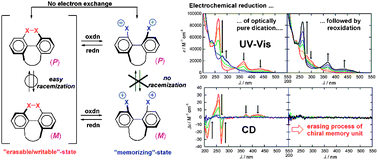The helical configuration of dication dyes 22+ with a dihydrodibenzoxepin unit remained unchanged even at high temperature, whereas the corresponding neutral electron donors 1 with a tetrahydrophenanthroxepin skeleton easily underwent racemization. Due to their electrochemical bistability, electron exchange between 1 and 22+ is prohibited. Thus, the above electrochromic pairs can serve as novel chiral-memory units where redox reactions trigger switching between an “erasable/writable”-state (1) and a “memorizing”-state (22+).

